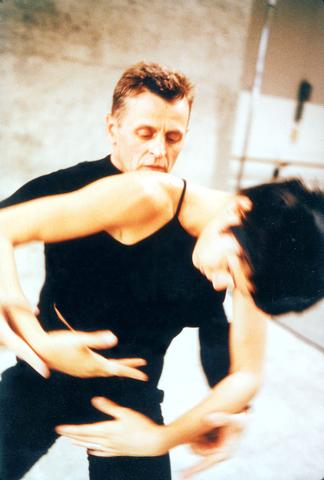Mikhail Baryshnikov. The name alone is enough to fill seats in theaters around the world. At an age (53), when most ballet dancers have hung up their tights, retired from the stage to teach or to appear briefly in character parts such as Romeo or Juliet's parents, Baryshnikov is still moving forward, still exploring the limits of dance.
Now he does so as the co-founder, lead dancer and principal mover and shaker of the White Oak Dance Project, which is in Taipei tonight through Sunday night. And let's be frank, it is the magic of Baryshnikov's name -- which even non-balletomanes have heard through his film work or his colorful love life lavishly reported in gossip columns -- and his rare physical brilliance, which are White Oak's main drawing cards.
No matter how good the other dancers or choreographers are, modern dance doesn't draw the crowds that classical ballet does. There are far more people who have seen Swan Lake than have seen Merce Cunningham's Signals.

PHOTO COURTESY OF THE WHITE OAK DANCE PROJECT
Baryshnikov made a sensational entrance into the international dance scene in 1974, when he defected from Russia's Kirov Ballet while on tour in Canada. His defection immediately created the kind of buzz not seen since his compatriot Rudolf Nureyev made his dash for freedom over a decade before in Paris.
Though renowned as a ballet dancer (has anyone else leapt so high or spun so fast around a stage in the flashy La Corsaire pas de deux?) Baryshnikov has been interested in all forms of dance. He moved easily from the classical repertoire to the abstract choreography of Georg Balanchine and Roland Petit, from the modern dance of Martha Graham to Broadway musicals and the classic film dances of Fred Astaire or his favorite, Jimmy Cagney, the movie tough guy who hoofed his way through Yankee Doodle Dandy.
Baryshnikov jumped from the Kirov straight into the American Ballet Theater (ABT) and then to Balachine's New York City Ballet because of his desire to experiment with different dance forms, to work with different choreographers, to work with the best.
But he always seemed to be trying to show that dance was more than the rigid forms prescribed by the ballet repertoire or the sterile abstractness of modern forms. He wanted to show that dance could be taken, by dancer and audience alike, both seriously and yet be a lot of fun.
For those who were awed by Baryshnikov's performances as the doomed heroes in Giselle or Swan Lake, the dancer showed off a whole new facet of his talent, and his strong sense of humor came through in pieces like Twyla Tharp's Push Comes to Shove.
Just as this desire to experiment was key to Baryshnikov's personal development as a dancer, it also proved crucial to his 10-year tenure as artistic director of the ABT, as he moved to expand its repertoire with pieces from some of the best contemporary choreographers. One of those collaborations, with Mark Morris, the dance Wunderkind of the 1980s, proved prophetic.
Baryshnikov commissioned Drink to Me Only With Thine Eyes from Morris for ABT in 1990 and that led to these two dance greats to decide to collaborate on a more long-term basis, by forming the White Oak Dance Project, a small, ever-changing ensemble of elite dancers from the top companies, performing specially commissioned works and resurrecting hallmark pieces by Jerome Robbins, Jose Limon, Paul Taylor and Trisha Brown.
The idea was to showcase the best of the best from the choreographers that inspire them the most. And while Baryshnikov is a founder of the project and the name that draws people in, the focus of White Oak is the ensemble.
At Taipei's National Dr Sun Yat-sen Memorial Hall, the White Oak Project will present four pieces from its current program titled "PASTForward," which draws inspiration from the epochal Judson Dance Theater of the 1960s, which was a center for a group of dancers, filmmakers and theater directors who pioneered postmodern dance.
Two of the works into this weekend's performances, Concerto by Lucinda Childs and For the Love of Rehearsal by David Gordon, are by choreographers who were instrumental in the Judson Dance Theaters. The other two pieces, The Argument, and Pecadillos are by White Oak Project co-founder Morris.
Childs is known for her pared-down choreography with severe, geometric designs and the focus on the relationship between the dancers. Concerto, features all seven dancers in the project and is one of the more accessible of Child's pieces. The dancers in the piece not only move to the music, they seem to become the music.
David Gordon's For The Love of Rehearsal is a reflection of dance both on-stage and off. Set to Johann Sebastian Bach's Six Preludes from the Cello Suites, Gordon aims to remove the barriers between what the audience sees on stage and what is usually hidden by the proscenium and side curtains of a stage. Instead of entering or leaving the stage to mark the beginning and end of each section, the dancers simply stop, walk around, or remove a piece of their costume.
The two pieces by Mark Morris both feature Baryshnikov. The Argument, is a pas de deux in which Baryshnikov's partner is another alumni of New York City Ballet, Emily Coates. Pecadillos is a solo. With Morris, the essential thing to remember is to expect the unexpected.
One bonus of the White Oak Project's performances is that the music is not a playback recording. The dancers will be accompanied by pianist Pedja Muzijevic and cellist Alberto Parrini, who will hopefully prove to be a blessing and not a distraction, despite the hall's notoriously poor acoustics.
What The White Oak Dance Project
When National Dr Sun Yat-sen Memorial Hall
Where Tonight, tomorrow and Sunday, Feb.23 - Feb.25 at 7:30pm
Tickets NT$600,NT$800,NT$1,000,NT$1,200,NT$2,000,NT$2,500,NT$3,000

As we live longer, our risk of cognitive impairment is increasing. How can we delay the onset of symptoms? Do we have to give up every indulgence or can small changes make a difference? We asked neurologists for tips on how to keep our brains healthy for life. TAKE CARE OF YOUR HEALTH “All of the sensible things that apply to bodily health apply to brain health,” says Suzanne O’Sullivan, a consultant in neurology at the National Hospital for Neurology and Neurosurgery in London, and the author of The Age of Diagnosis. “When you’re 20, you can get away with absolute

When the South Vietnamese capital of Saigon fell to the North Vietnamese forces 50 years ago this week, it prompted a mass exodus of some 2 million people — hundreds of thousands fleeing perilously on small boats across open water to escape the communist regime. Many ultimately settled in Southern California’s Orange County in an area now known as “Little Saigon,” not far from Marine Corps Base Camp Pendleton, where the first refugees were airlifted upon reaching the US. The diaspora now also has significant populations in Virginia, Texas and Washington state, as well as in countries including France and Australia.

On April 17, Chinese Nationalist Party (KMT) Chairman Eric Chu (朱立倫) launched a bold campaign to revive and revitalize the KMT base by calling for an impromptu rally at the Taipei prosecutor’s offices to protest recent arrests of KMT recall campaigners over allegations of forgery and fraud involving signatures of dead voters. The protest had no time to apply for permits and was illegal, but that played into the sense of opposition grievance at alleged weaponization of the judiciary by the Democratic Progressive Party (DPP) to “annihilate” the opposition parties. Blamed for faltering recall campaigns and faced with a KMT chair

A police station in the historic sailors’ quarter of the Belgian port of Antwerp is surrounded by sex workers’ neon-lit red-light windows. The station in the Villa Tinto complex is a symbol of the push to make sex work safer in Belgium, which boasts some of Europe’s most liberal laws — although there are still widespread abuses and exploitation. Since December, Belgium’s sex workers can access legal protections and labor rights, such as paid leave, like any other profession. They welcome the changes. “I’m not a victim, I chose to work here and I like what I’m doing,” said Kiana, 32, as she